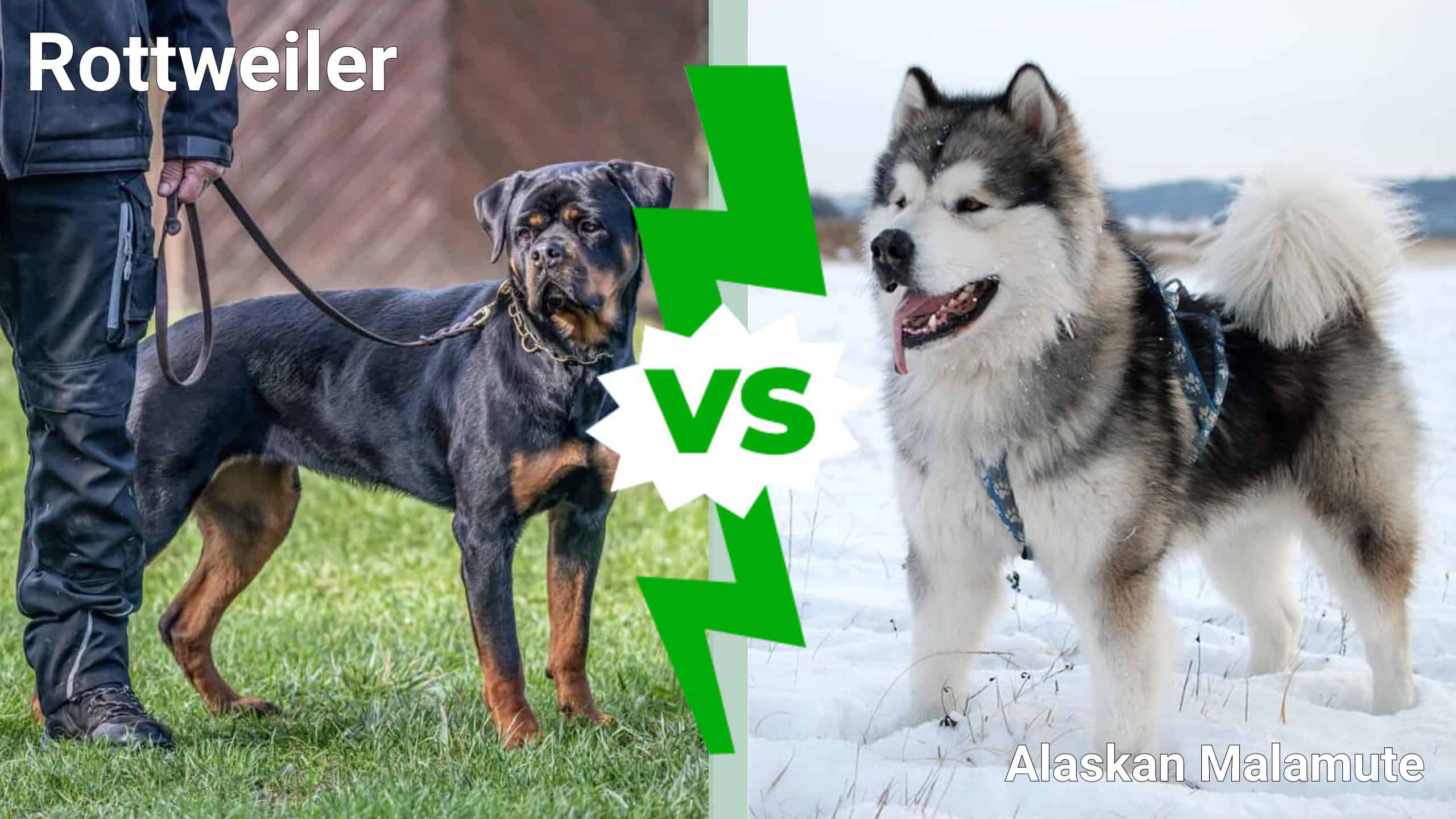Rottweilers and Alaskan Malamutes are pure-breed dogs that share a lot of similarities. Both Rottie and Mally, as they are often called, are pretty popular breeds and great to have if you live in the house. But they are probably not the best option if you live in an apartment due to their size and excessive shedding.
Both breeds also need lots of exercise. Rottweilers are active and require daily walks, playtime, and mental stimulation to stay healthy and happy. On the other hand, Alaskan Malamute are sled dogs with high energy levels. They thrive with regular, vigorous exercise and enjoy activities like sledding and hiking.
However, despite their many similarities, Rottweilers and Alaskan Malamutes also have some important differences. We’ll list the nine most important ones in this article.
Rottweiler vs. Alaskan Malamute: Comparison
Let’s start with a quick comparison between Rottweilers and Alaskan Malamutes.
| Comparison | Rottweiler | Alaskan Malamute |
|---|---|---|
| Height | Males: 24-27 inches / Female: 22-25 inches | Male: 24 – 26 inches / Female: 22 – 24 inches |
| Weight | Male: 95-130 pounds / Female: 85-115 pounds | Male: 80 – 95 pounds / Female: 70 – 85 pounds |
| Coat type | Short, Dense, Light Shed | Thick, Medium-Length Double Coat, Heavy Shed |
| Colors | Mahogany, Tan, Rust, Black | Black, Grey, White, Red, Brownish, Sable |
| Temperament | Independent, Courageous, Protective, Alert, Intelligent, Loyal | Friendly, Playful, Affectionate, Devoted, Can Be Stubborn |
| Social Needs | Very High (Quite People-Oriented) | Average (Average Pack Animals) |
| Life Expectancy | 8 to 11 years | 10 to 14 years |
| Health Problems | Hip and Elbow Dysplasia, Allergies, Bloat, Aortic Stenosis, and Hypothyroidism | Hip and Elbow Dysplasia, Dwarfism, Thyroid Disease, Polyneuropathy, Day Blindness, and Blood Clotting Disorders |
| Exercise requirement | High | Very High |
| Litter Size | 8-12 Puppies | 4-10 Puppies |
9 Key Differences Between Rottweiler and Alaskan Malamute
Now, let’s look at the most interesting differences in more depth.
#1 Origin
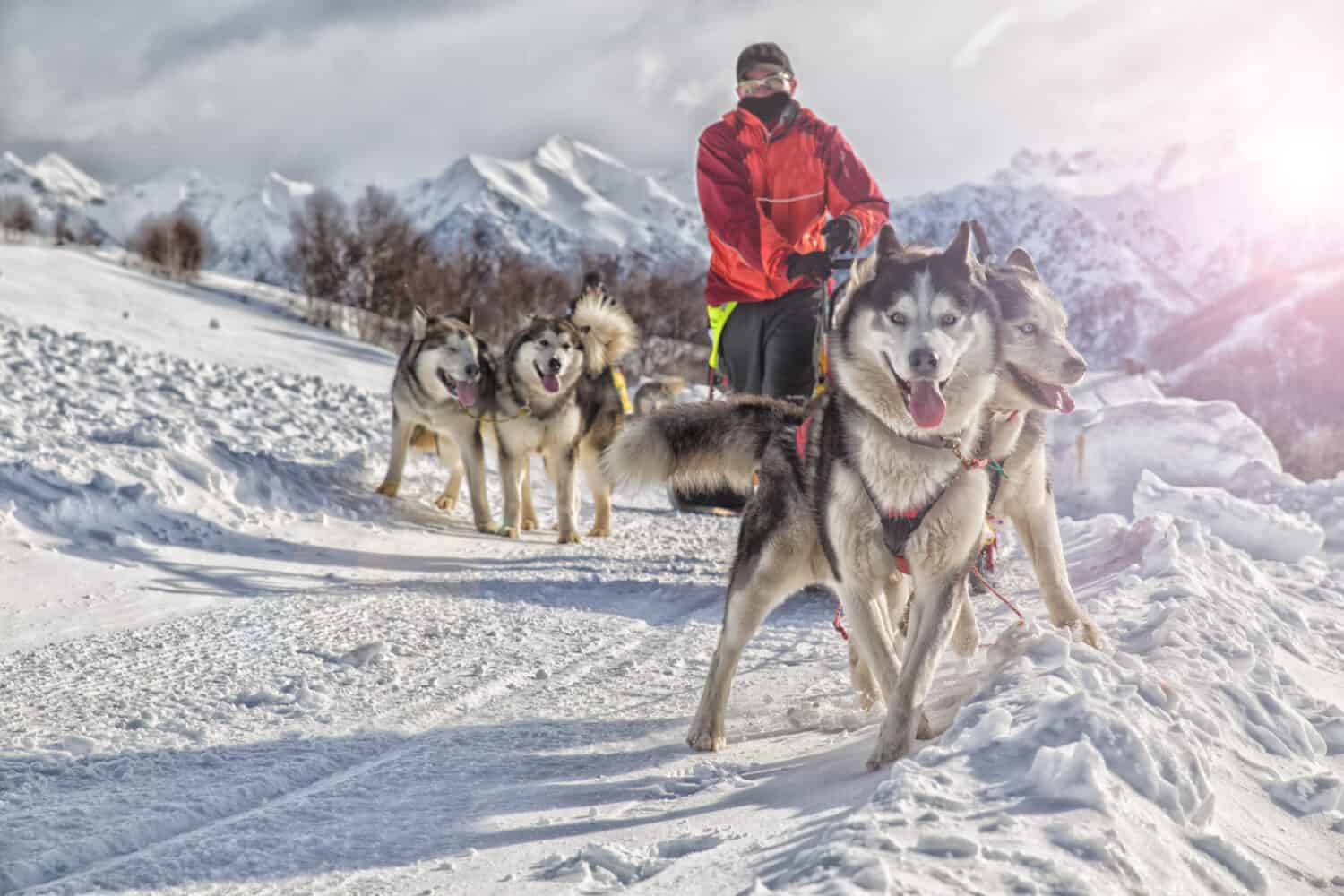
Alaskan Malamutes are believed to be descendants of the domesticated wolf-dogs.
©freevideophotoagency/Shutterstock.com
Though considered to be from Germany, Rottweilers actually descended from cattle-driving dogs left by the Roman legions close to what is now Rottweil, Germany, where they get their name from. These dogs were interbred with local breeds, ultimately leading to the Rottweiler we know today.
The origin of Alaskan Malamute is, as the name suggests, from Alaska in the USA. They are one of the oldest sled dog breeds of the Arctic. Native Mahlemut tribe, Inuit people who resided in northwestern Alaska, used to breed these dogs, and that’s how they got their name. Because of their strength and endurance, they used them to haul heavy freight as sled dogs.
#2 Impulse to Wander
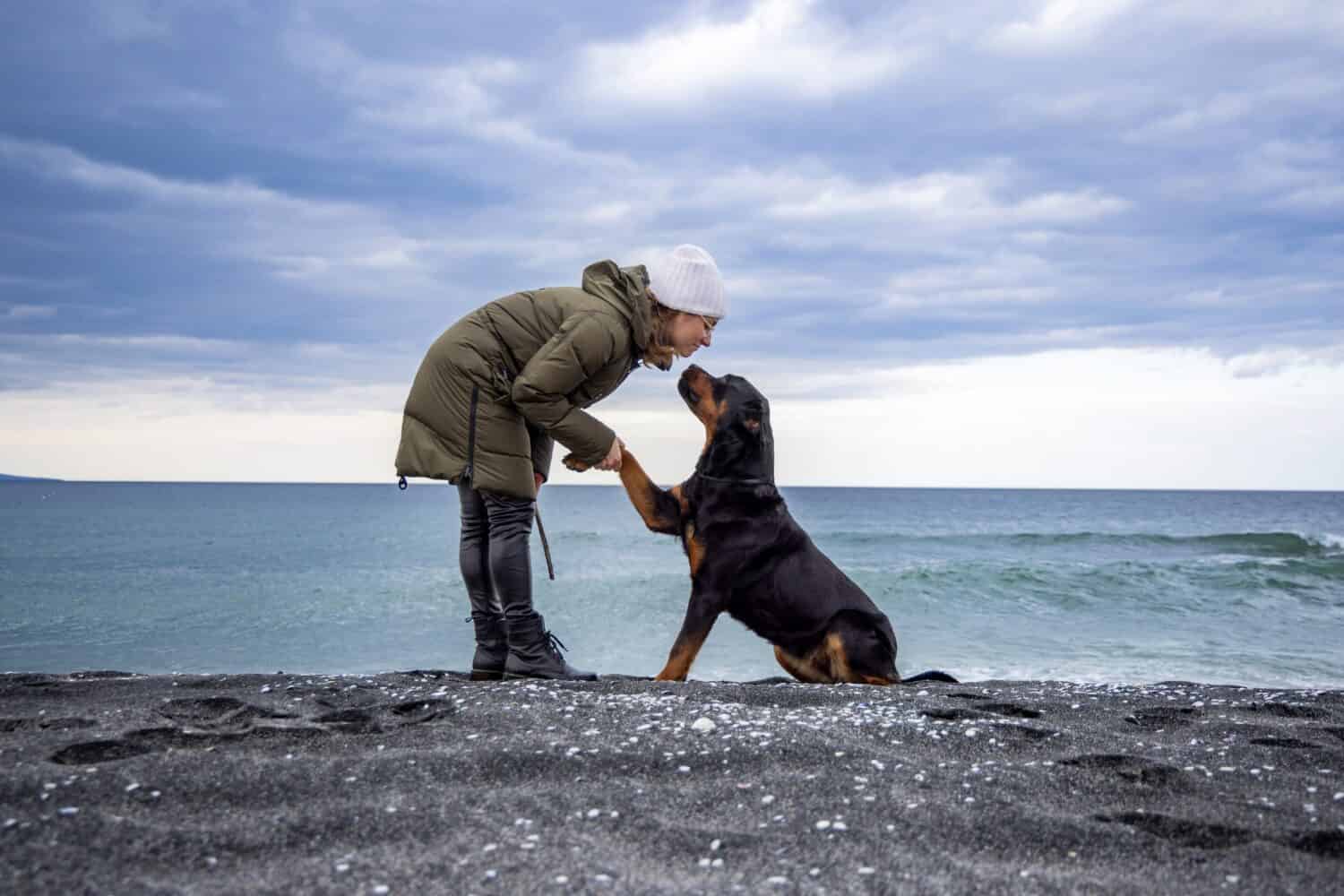
Most Rottweilers form deep connections with their owners, which makes them less likely to blindly follow their impulse to wander.
©YouraPechkin/Shutterstock.com
Mallies possess a strong impulse to wander. They’re naturally inclined to explore the world around them, so owners should be aware of this and take the necessary precautionary measures. For example, it may not be wise to take Mallies outside without a leash. You never know when they’ll find something more interesting to follow!
Rotties, on the other hand, tend to escape less than other breeds and are extremely loyal dogs. Because of their great need to bond closely with their owner, they often suffer from separation anxiety and don’t like being alone for extended periods of time. That means you can freely let most Rotties explore the world without a leash, but you’ll need to put extra effort into organizing your day to avoid leaving them home alone for too long.
#3 Barking and Howling
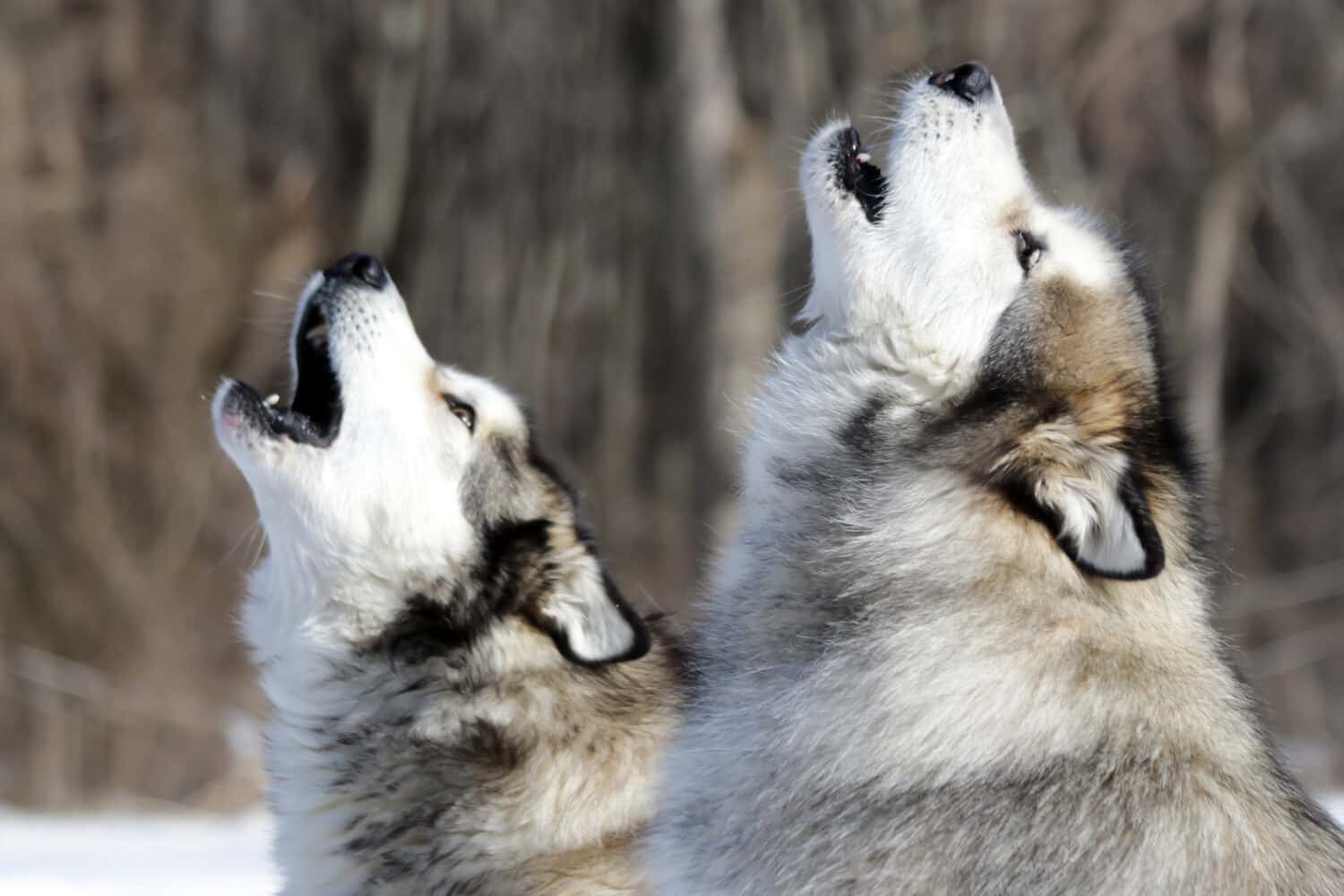
Mallies love howling, which may go to confirm their connection with domesticated wolf-dogs.
©Kate Lussier/Shutterstock.com
Alaskan Malamutes don’t bark a lot but are big howlers instead, which could be problematic for intolerant neighbors. Rottweilers, on the other hand, are not a vocal breed, so you will rarely hear them bark. They also almost never howl.
So, if you’re apartment-based or live close to other neighbors, Rottweilers may be a slightly better choice. Still, it’s important to note that neither Rotties nor Mallies are prone to excessive vocalizations. In fact, they may be significantly more silent than many other breeds.
#4 Weight Gain
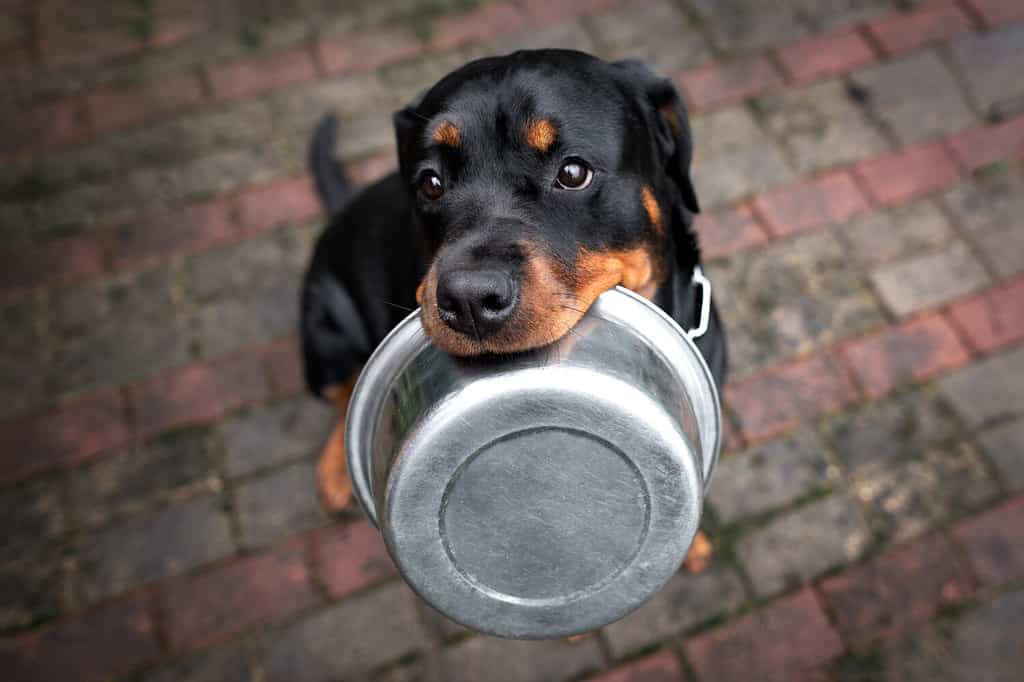
Rottweilers love to eat! It’s up to you to keep their weight in check.
©otsphoto/Shutterstock.com
Alaskan Malamutes have a low to moderate risk for obesity. That means they should definitely stick to a well-rounded diet to avoid unwanted weight gain — but they are not likely to put on a ton of weight if they have an occasional fatty treat here and there.
Rottweilers, on the other hand, are much more prone to obesity, so you should closely monitor them to ensure they are not over-eating. They need to consume around 1,600 to 2,300 calories per day; anything more is exposing them to the risk of obesity.
#5 Shedding

Not a big fan of clumps of dog hair lying around your home? Then Mallies may not be the best choice.
©smrm1977/Shutterstock.com
Malamutes shed year-round — a lot! This is something to bear in mind if you have carpets all over your house and are on a grooming budget. Rottweilers shed moderately, with slightly heavier shedding in the spring and fall, and they require minimal grooming.
#6 Drooling

You’ll get along with Rotties just fine, as long as you don’t mind wet kisses.
©McCann Michelle/Shutterstock.com
Alaskan Malamute has a very low drooling tendency. The Rottweiler is on the other end of the spectrum and drools quite a lot. So, if you’re not a fan of drool, the Mally might be the more appealing option for you.
#7 Service and Therapy Dog
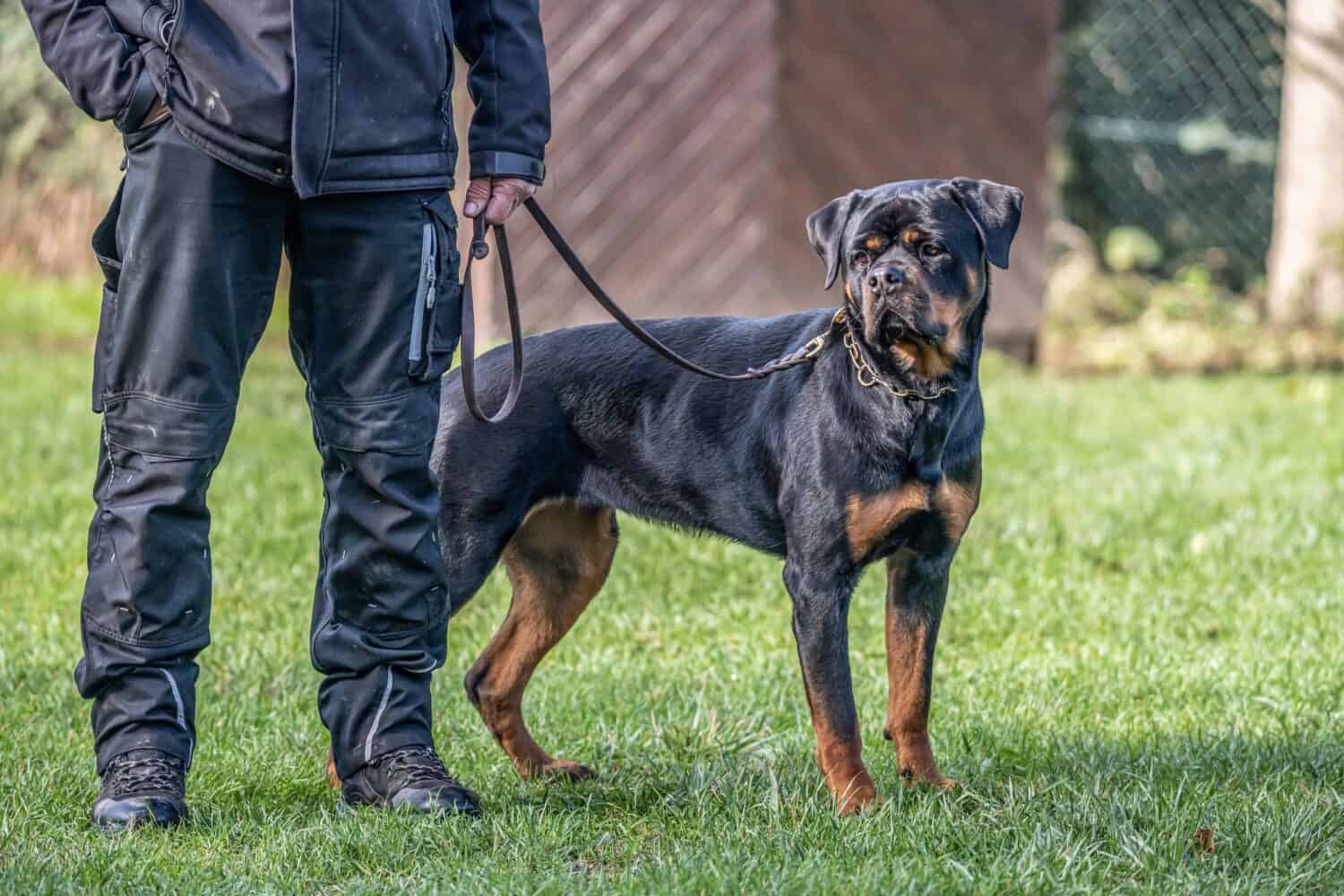
Rottweilers have long been used as both police and military dogs.
©CL-Medien/Shutterstock.com
Alaskan Malamutes are not usually used as service or therapy dogs, while Rottweilers are an excellent choice for both. They are highly trainable and always aim to please their owners, which makes them quite obedient. With the right training, they can provide psychiatric assistance, mobility assistance, and many other forms of support.
Thanks to these characteristics, Rottweilers have long been used in the police and military forces. They are not as popular today, perhaps due to the fact that they are simply not as fast nor light (i.e., easy to carry) as some other breeds.
#8 Pet and Stranger Friendly
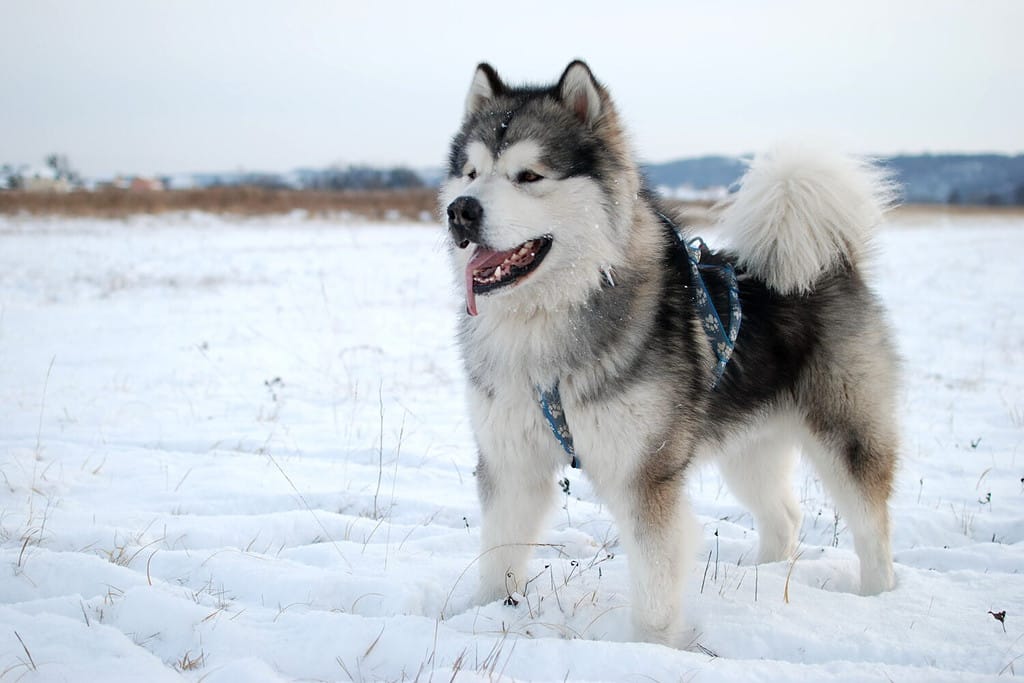
Alaskan Malamutes fit the stereotype of lone wolves much better than Rottweilers.
©DiLiDon/Shutterstock.com
Rottweilers are generally very friendly to other pets in the house, including cats. In contrast, Alaskan Malamutes aren’t keen on forming friendships with other house pets.
Despite this, Alaskan Malamutes can be stranger-friendly outside the house, particularly towards other dogs and people. Rottweilers provide a stark contrast, as they’re very protective of their inner circle but don’t like strangers. This is exactly why many consider them to be one of the most dangerous dog breeds.
#9 Climate
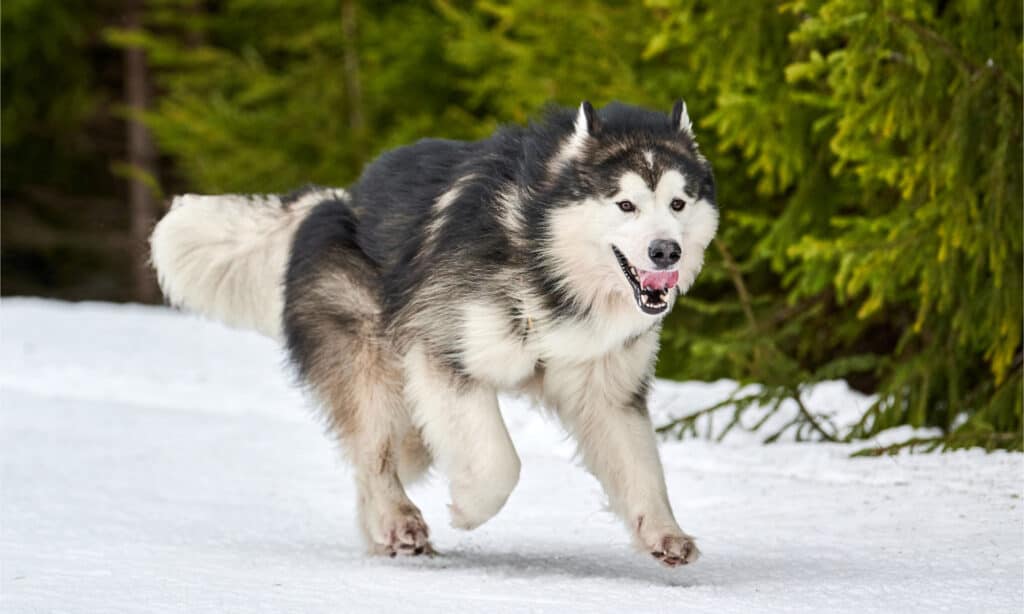
Alaskan Malamutes thrive in snowy, cold weather.
©travelarium.ph/Shutterstock.com
The Alaskan Malamute adapts well to harsh weather conditions and prefers cold weather. They are also known to be more susceptible to heat strokes, so people living in hot climates should reconsider having them.
Rottweilers, on the other hand, prefer average to warm weather conditions. They can adapt to colder weather, but extended exposure to sub-freezing temperatures is not advisable.
Rottweiler vs. Alaskan Malamute: How To Choose
When it comes to choosing between a Rottweiler and an Alaskan Malamute, one thing is for sure: both are magnificent breeds. Each breed has its strengths and weaknesses, so it’s really up to you which ones you prefer.
To ensure you find a perfect pet, you need to research and understand their histories, temperaments, and needs. Choose wisely, and you’ll have a loyal companion for years to come.
Summary of Rottweiler vs. Alaskan Malamute: 9 Key Differences
| Difference | |
|---|---|
| #1 | Origin |
| #2 | Impulse to Wander |
| #3 | Barking and Howling |
| #4 | Weight Gain |
| #5 | Shedding |
| #6 | Drooling |
| #7 | Service and Therapy Dog |
| #8 | Pet and Stranger Friendly |
| #9 | Climate |
Ready to discover the top 10 cutest dog breeds in the entire world?
How about the fastest dogs, the largest dogs and those that are -- quite frankly -- just the kindest dogs on the planet? Each day, AZ Animals sends out lists just like this to our thousands of email subscribers. And the best part? It's FREE. Join today by entering your email below.
Thank you for reading! Have some feedback for us? Contact the AZ Animals editorial team.

